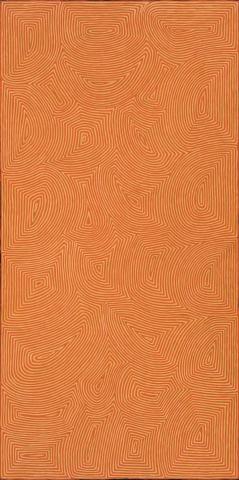MAMULTJULKUNGA, 1999
GEORGE TJUNGURRAYI
synthetic polymer paint on canvas
246.0 x 121.0 cm
inscribed verso: artist's name, size and Papunya Tula Artists cat. GT9901121
Papunya Tula Artists, Alice Springs
Scott Livesey Gallery, Melbourne
Private collection, Melbourne
This work is accompanied by a certificate of authenticity from Papunya Tula Artists.
Since the late 1980s art emerging from Papunya Tula has re-invented itself at regular intervals. Traditional representations of the Tingari creation cycle, the roundels, connecting meandering lines and dots have given way to optical line work that reduce the painting to a simplicity of rhythm and tone, a variation and development that Judith Ryan refers to as 'a radical form of expression akin to western forms of minimalism in art and music'.1
The repeated rhythmic and optical patterns in the paintings of George Tjungurrayi generate a hypnotic effect where the interplay of undulating broad parallel lines, composed of different tones of the one colour, creates a mesmerizing surface. His compositions inspired by traditional narratives are derived from the distinctive western desert style of fluted carving of fine parallel lines carved into men's ceremonial shields and boomerangs. Tjungurrayi has transposed these designs onto canvas utilising both the motifs and the sculptural elements to create an extra dimension to the surface of his canvases.
This large impressive canvas depicts designs associated with the claypan and soakage water site of Mamultjulkunga, north-west of Lake Mackay. Here, two Tingari men, one of the Tjapaltjarri kinship subsection and one of the Tjangala kinship subsection, made camp at this site before continuing on their journey.
1. Ryan, J., 'Shock of the Ancient made New', in Laverty, C., Laverty, E., and Kleimeyer, J., Beyond Sacred: Recent painting from Australia's remote Aboriginal communities: The collection of Colin and Elizabeth Laverty, Hardie Grant Books, Prahran and Bambra Press, p. 16
